Snares penguin
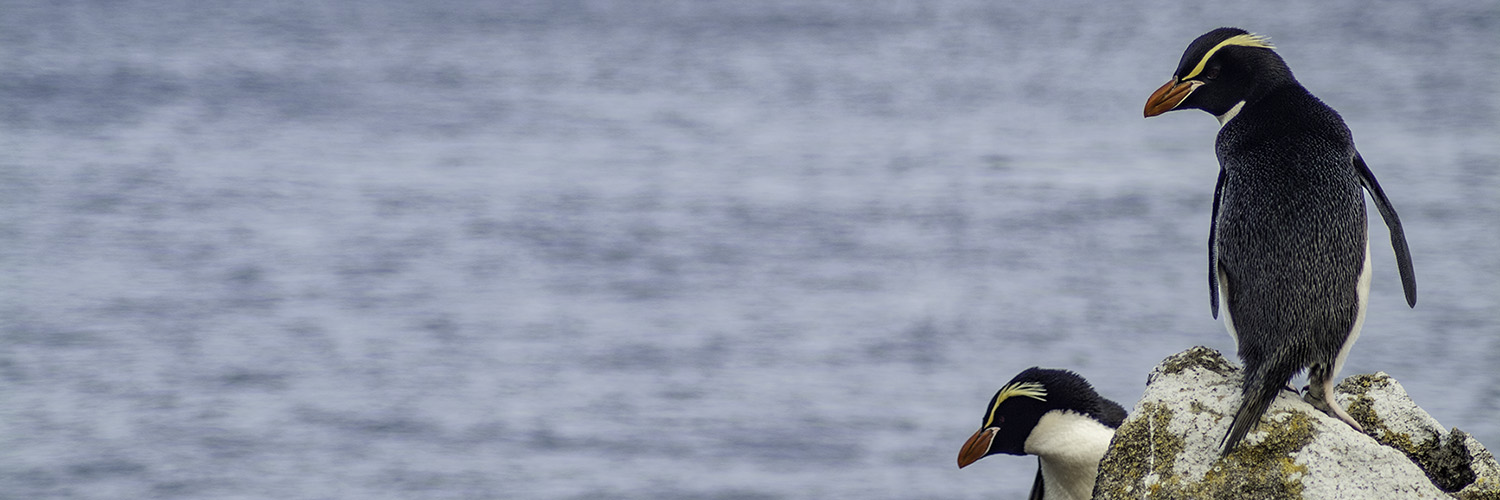
Snares penguin
Eudyptes robustus
| Thomas Mattern & Kerry-Jayne Wilson | Document date: 12 April 2019; DOI: 10.36617/SoP.snares.2019-04 |
Summary
The Snares penguin (Eudyptes robustus) is endemic to the small Snares archipelago some 200 km south of the New Zealand mainland. Although considered one of New Zealand’s sub-Antarctic island groups, The Snares are located north of the Subtropical Front (STF) so that from an oceanographic and ecological perspective the penguins’ breeding habitat is part of the same temperate zone as that of the three mainland species; tawaki (E. pachyrhynchus), little (Eudyptula minor) and yellow-eyed (Megadyptes antipodes) penguins. Unlike most other crested penguin species, the Snares penguin population appears to be stable at around 25,000 breeding pairs. However, the species’ limited breeding distribution justifies the threat classification ‘vulnerable’ as listed by the IUCN and ‘At Risk – Naturally Uncommon’ in New Zealand’s current conservation status assessment. Very little is known about the biology of this species. The most comprehensive study of the species was conducted in the late 1960s which focussed predominantly on breeding behaviour. Since then research projects have been few and limited. The diet has been assessed from chick dissection and stomach samples taken from breeding adult penguins indicating that krill is one of the main foods, although hard part remains of fish and squid suggest that these are important prey for the self-sustenance of adults. Limited information is available about the species’ foraging behaviour. During incubation, male penguins appear to forage to the east along the STF while females may forage closer to the island. During the chick guard period, GPS logger deployments on 19 female penguins suggested they forage to the north of the island. The winter dispersal has been studied using geolocators which showed that the birds spent the non-breeding period south of Australia.
Previous reviews of biology and priority lists
The first detailed research on Snares penguins was published by John Warham which primarily focussed on terrestrial aspects of their biology1. A comprehensive, encyclopaedic review was compiled by Marchant & Higgins2 which cites several sources that cannot be accessed today. Two unpublished reports by the Zoology Department of the University of Canterbury summarize studies of various aspects of the Snares penguin’s biology3,4. A more recent review of the Snares penguin5 was based on the few studies ever conducted on this penguin:
- The ability of Snares penguin chicks to recognise of their parent’s voices was studied in the 1980s6.
- A PhD study examined the foraging ecology in the early 2000s. GPS logger technology was still its infancy and provided limited information about at-sea movements and diving behaviour7; a quantitative study of diet was conducted around the same time8.
- Two further studies investigated incubation positions of eggs9 and the colouration of the penguins’ crests10.
- In 2013, the winter dispersal was studied using geolocation loggers11.
Research and conservation priorities for this penguin have been listed in Taylor12 and Mattern5. Both are largely based on extrapolation from other species and both stress the need for a better understanding of the species’ demography and marine ecology.
Conservation status
Department of Conservation lists Snares penguins as ‘At Risk - Naturally Uncommon’, criteria IE (island endemic) and OL (one location). The IUCN red list classifies the species as ‘Vulnerable’ due to the species being restricted to a single location making them susceptible to stochastic events27.
Taxonomy
Snares penguins have been recognised as a separate species since the 1950s13. Prior to this it was considered a subspecies of the erect-crested penguin (E. sclateri)14. The phylogenetic relationship between Snares penguins and tawaki (E. pachyrhynchus) have been debated. In the 1970s, the Checklist of New Zealand Birds considered Snares penguins, tawaki and erect-crested penguins as conspecifics15 despite morphological and ecological differences between each taxa 1,16,17. Subsequent studies that examined relationships using morphology, protein data, and mitochondrial and nuclear DNA have all supported the recognition of three separate species18–21. Nevertheless, one recent review of their taxonomic status still considered Snares and Fiordland penguins as conspecific22. Consultations by Birdlife International in 2014 led to the calculation of the Tobias score23, which demonstrated that Snares penguins should be considered a separate species from tawaki (https://docs.google.com/spreadsheets/d/1f_19T94NhYfrqZCONBMEoqQ_IMZn8DSGKb6wqQMiiUk/edit?usp=sharing).
There may be a substantial difference in the onset of breeding between the Snares penguins on the main island and those on the nearby Western Chain, with Western Chain penguins breeding 15 to 44 days later than those on the main island24–26. Considering that the temporal separation of breeding between Fiordland and Snares penguins has been important in the most recent species status, a closer examination of the Western Chain population is urgent5. A phylogenetic comparison using mitochondrial DNA found no evidence to suggest birds from the Snares and Western Chain are different from one another18.
Distribution
Snares penguins only breed on the Snares Islands (S48.024o, E166.603°), a small archipelago (ca. 3 km²) approximately 200 km south of mainland New Zealand. The penguins predominately inhabit the eastern regions of North East Island, Broughton Island and the Western Chain, a chain of rocky islands ca. 5 km to the west of North East Island5. The species has probably always been restricted to these islands, and based on fossil evidence, it is unlikely they ever inhabited the New Zealand South Island (Teresa Cole, unpublished data).
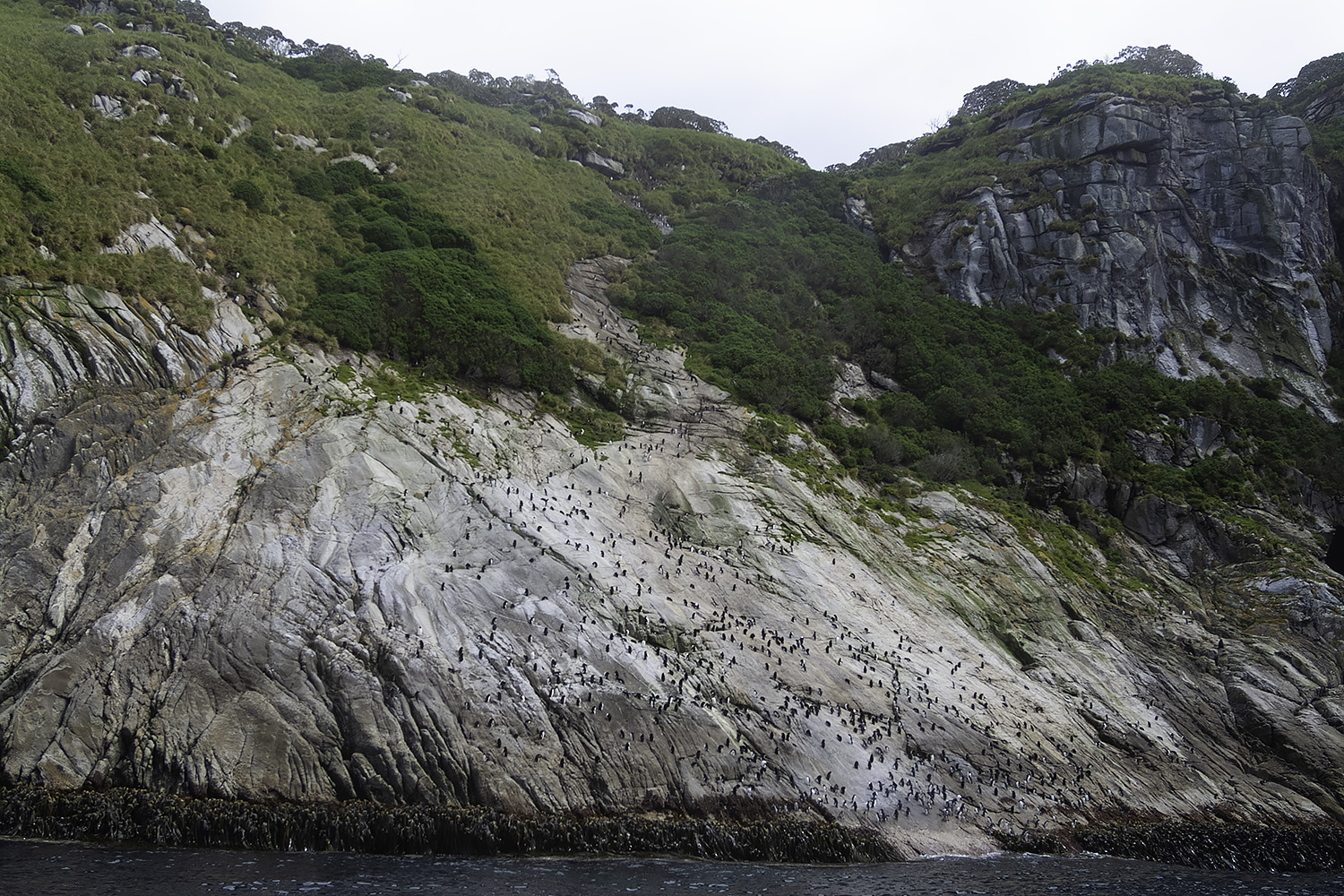
Figure 1. Penguin Slope on North East Island, The Snares (Photo: Thomas Mattern)
During the breeding season, Snares penguins seem to remain within 200-300 km of the Islands while eggs are incubated, with foraging ranges further restricted to 50-80 km to the north of the Island during the chick guard stage7. No information about the at-sea distribution is available for the crèching stage of chick growth or the pre-moult period. When not breeding, Snares penguins forage in sub-Antarctic and sub-tropical seas south of Australia11. Moulting Snares penguins are frequently observed on the mainland, the Chatham Islands28, Tasmania29,30, and Macquarie Island2. There are two reports of Snares penguins reaching the Falkland Islands31,32.
Numbers and population trends
Early estimates of population size ranged from 11,000 to 20,000 breeding pairs1,3,4,33. Those estimates were based on chick counts and likely underestimated the true population size5. Nevertheless, these chick counts revealed a general trend of a population increase between 1968 and 1986 although the author was cautious and added that this “general increase” could also be accounted for by variation in reproductive success34. Since 2000, four complete land-based population counts have been conducted by the Department of Conservation; the next census is scheduled for October 2020 (Joseph Roberts, DOC Southland, pers. comm.). These four censuses ranged between 24,666 and 30,000 nests (Table 1)35. Overall, the population can be considered stable today. Based on molecular data of fossil bones, museum skins and contemporary blood samples, the population has probably remained stable over at least the last millennia18. Moreover, there is no indication that Snares penguins have experienced major shifts in the prey composition that may have caused population declines8.
| Year of count | Method | Number of breeding pairs | Reference |
|---|---|---|---|
| 1968 | Chick counts | 11,000 | Warham1 |
| 1982 | Chick counts | 20,000 | Warham et al.32 |
| 1985 | Chick counts | 37,600 | Warham et al.32 |
| 1985 | Chick counts | 23,250 | Marchant & Higgins2 |
| 2000 | Nest counts | 30,577 | Hiscock & Chilvers33 |
| 2008 | Nest counts | 24,666 | Hiscock & Chilvers33 |
| 2010 | Nest counts | 30,672 | Hiscock & Chilvers33 |
| 2013 | Nest counts | 29,009 | Hiscock & Chilvers33 |
Demography
There is no robust data available on the key demographic parameters. A first attempt at collating a life history table for Snares penguins was based on a banding programme initiated in 1968 and was presented at the 1st International Penguin Conference in 1988. Based on various expedition reports3,4, the published abstract36 states that the oldest bird recorded was 21+ years. From that life table, chick survival varied greatly between years with first year survival ranging from 4.9% in 1982/83 to 39.2% the following year. Fewer than 50% of banded adults found had been sighted as yearlings. Annual survival of birds aged one to five years is given as >50%.
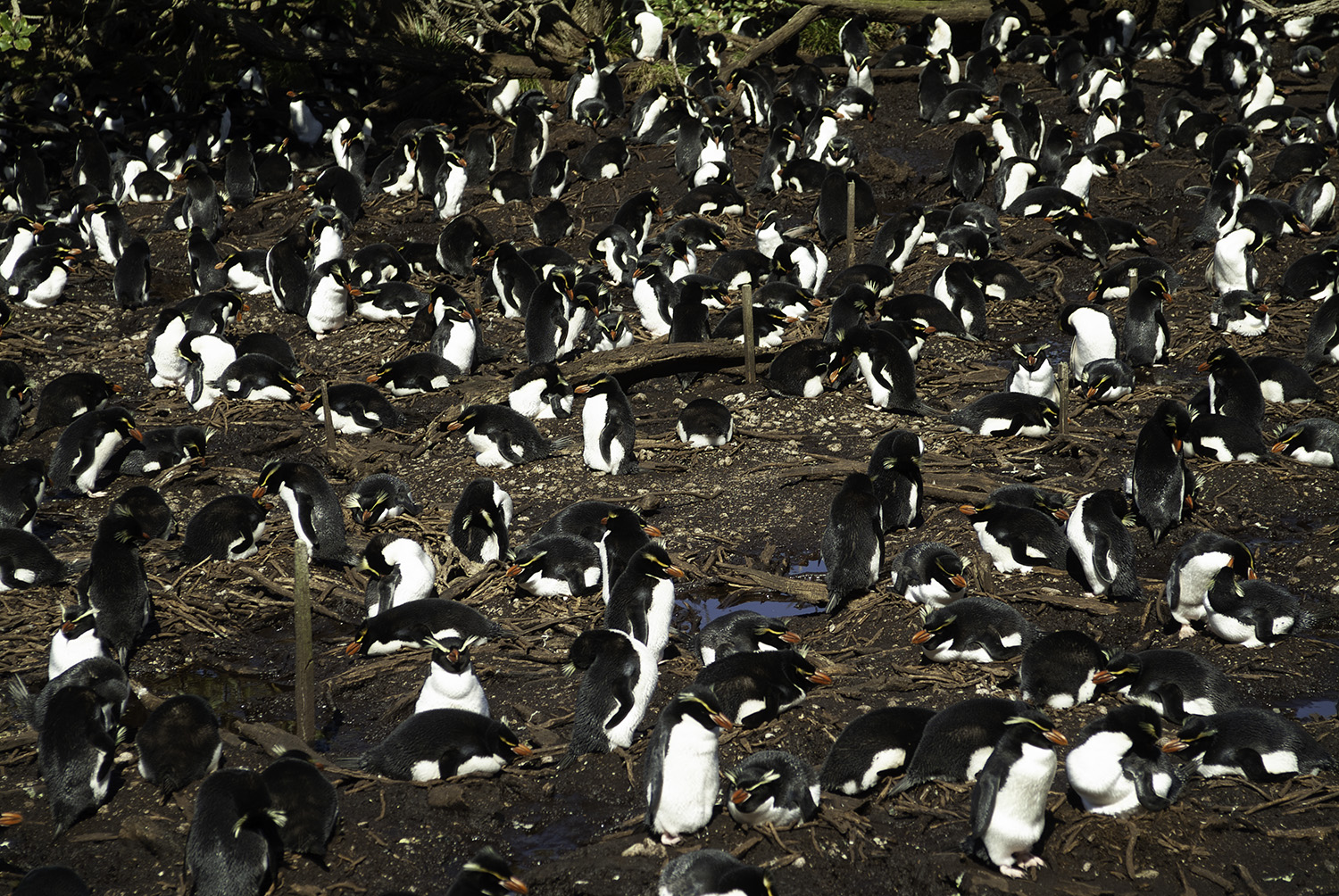
Figure 2. Snares penguin colony on North East Island, The Snares (Photo: Thomas Mattern).
Breeding biology
On North East Island, Snares penguins breed in colonies of ranging from 10 up to 1,400 nests (median: 137 nests, n=112 colonies; Amey et al. 2001). Most colonies are located under a forest canopy of the tree daisy (Olearia lyalli) or in between Hebe elliptica shrubs; larger colonies have killed off all vegetation within the confines of the colony5. On Broughton Island, colonies are situated in the open1 while on the Western Chain penguins breed under boulders and in rock crevices38 probably reflecting habitat available rather than penguin preference. Nests are usually scooped-out hollows lined with mud and peat mixed with stones, twigs, or bones5.
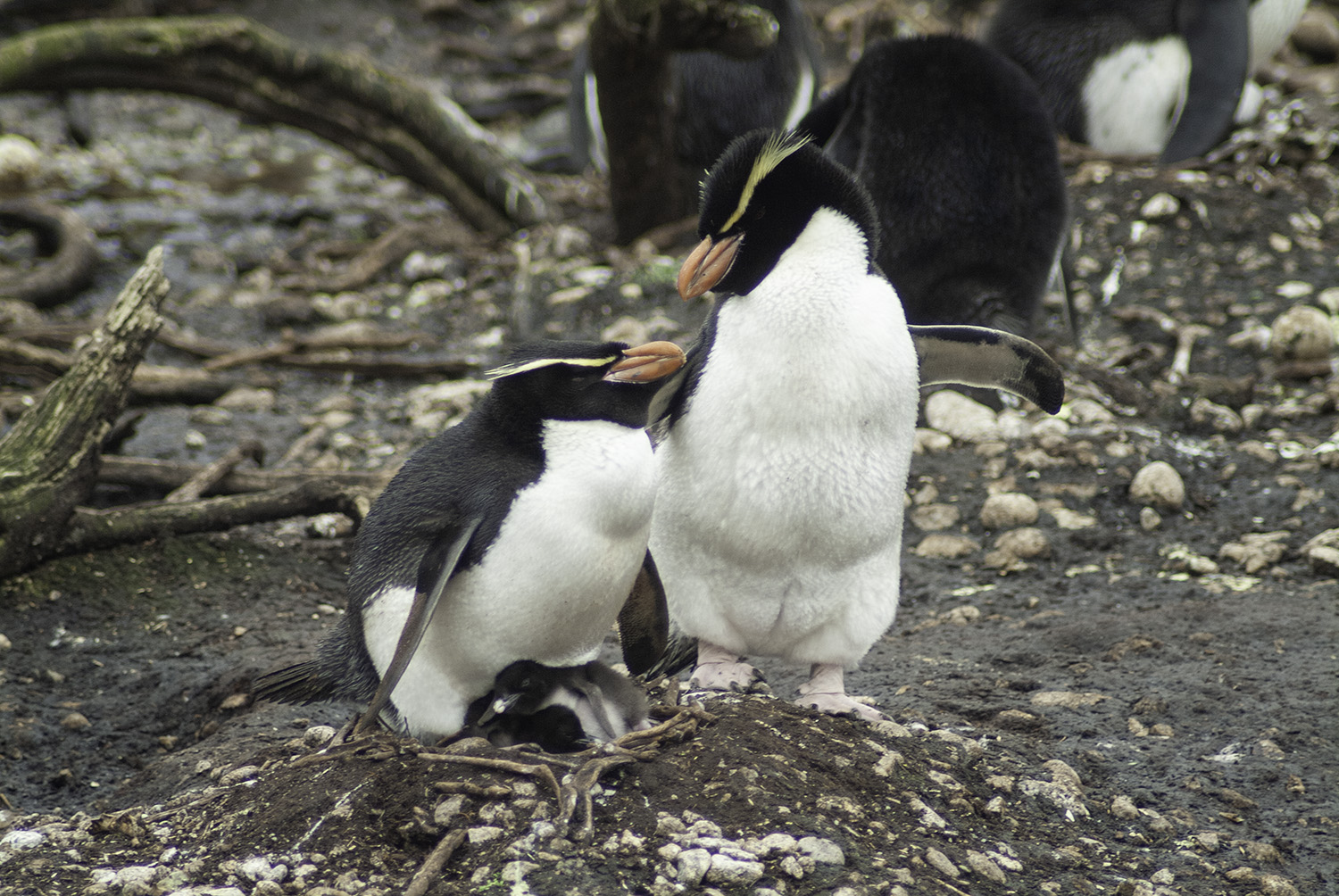
Figure 3. Snares penguin nest with the female incubating two chicks with the male attending (Photo: Thomas Mattern).
Their breeding biology is the only aspect of the Snares penguins’ ecology that has seen comprehensive investigation1. The species breeding period is well defined with highly synchronous annual patterns. Adults arrive in early September from their winter dispersal. The two eggs comprising the clutch are laid approximately 4-5 days apart in late September and early October. Both adults stay at their nest until mid-October when male penguins leave the island to forage for about 2 weeks while females incubate the eggs. The male exodus is highly synchronized and appears to happen every year around 13 October, suggesting that day length (photoperiod) may be an important trigger39. Once males return, the females leave on a foraging trip which lasts around a week, to return in time for the hatching of the eggs. The smaller first-laid egg (A-egg) usually hatches after the larger, second laid B egg, although in clutches with more pronounced egg-size differences the A-egg may hatch at the same time or even earlier than the B-egg9. Both eggs hatch in about 60% of nests, but chicks from the A-egg usually die within a week after hatching1. On rare occasions, both chicks survive until the crèche stage5. The male penguins guard their offspring for their first three weeks after hatching at which time the chicks start to form crèches. During the crèche stage, both parents forage although it is predominantly the females that feed their chicks. It appears that chicks are able to recognize their parents by voice very soon after hatching6,40. Chicks fledge in mid-to late January; by early February, when adults leave on the pre-moult trips, all chicks have left the island1.
Moult
Chicks start to shed their down in late December and have completed their moult into juvenile plumage by mid-January1. Yearlings return to the island in early November but only start to moult in mid-January; once moulted into their adult plumage the young birds leave the island in early February. Adult Snares penguins return from their pre-moult migration in mid-March. It takes the birds between 24 and 30 days to fully replace their feathers and the island starts to empty of penguins from late April. By late May, all penguins have left the island.
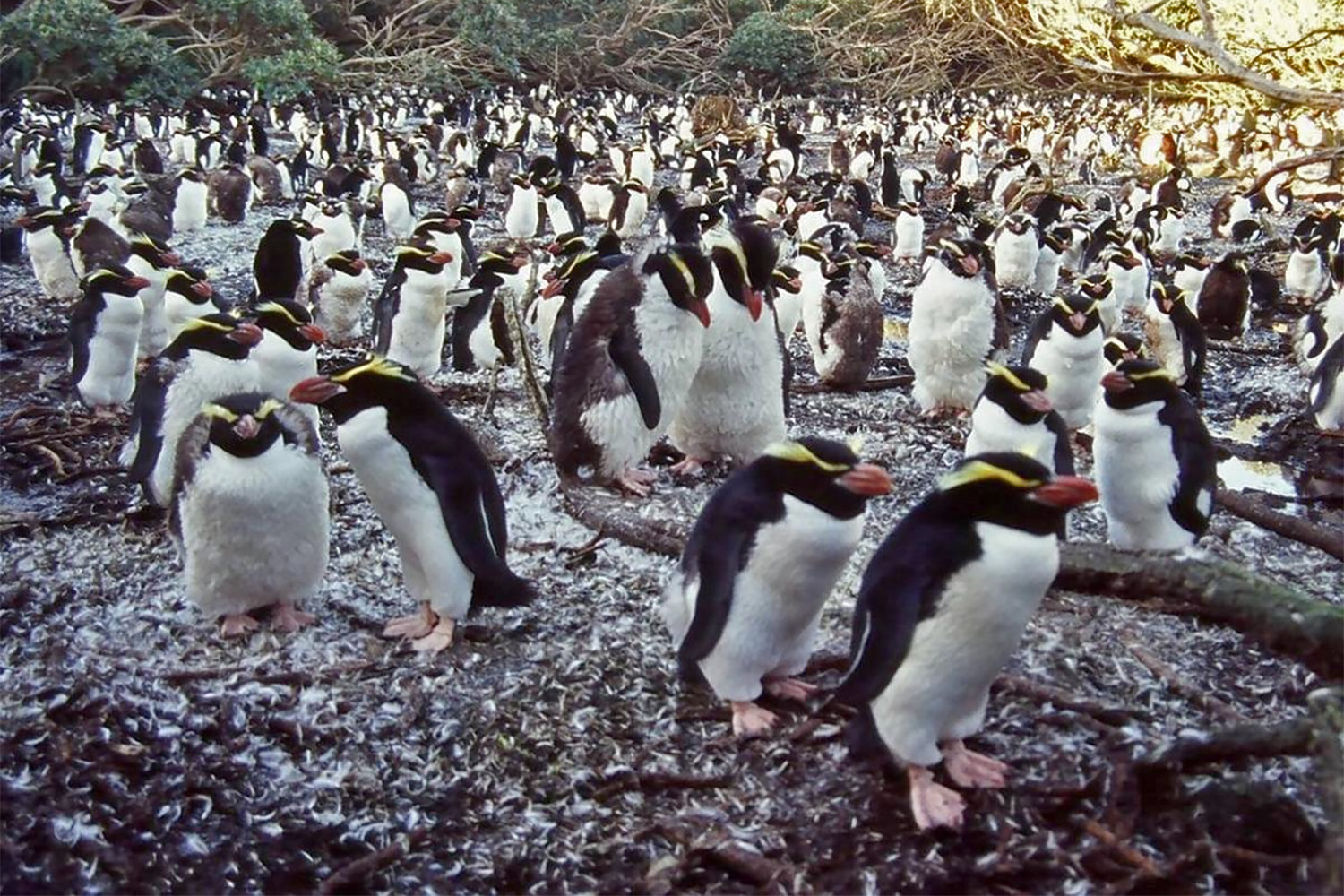
Figure 4. Moulting Snares penguins, North East Island, The Snares, April 2005 (Photo: Colin Miskelly, NZ Birds Online)
Food and foraging
The limited information on Snares penguin foraging ecology available derives mainly from a three year study that investigated the penguins’ at-sea movements using GPS loggers and dive recorders7. GPS loggers suitable for use on deep-diving animals were still in their infancy, the study was plagued by technical problems as well as the need to develop best-use practices and programming41. As a result, the study did not record any data in its first year, partial foraging tracks (the first 2-3 days) of just three male penguins during the incubation period39 as well as five data sets from females feeding young chicks in the second year, and, in the third year, 14 GPS data sets on chick rearing females7. Better results were achieved with the dive recorders where data representing 18 foraging trips were recorded in the second year, and 14 foraging trips in the third year.
Data suggested that during incubation, male penguins foraged due east of the Snares towards the Subtropical Front (STF) some 200-300 km from the island. Their movement trajectories seemed to coincide with the onset of the spring phytoplankton bloom at the STF39. While travelling the penguins were diving no deeper than 30-40 m; however, once at the STF dives of up to 120 m were recorded39. No GPS data was obtained for females during the incubation period, but ambient temperatures recorded by the dive loggers on two females indicated that the birds remained in warmer waters north of the STF.
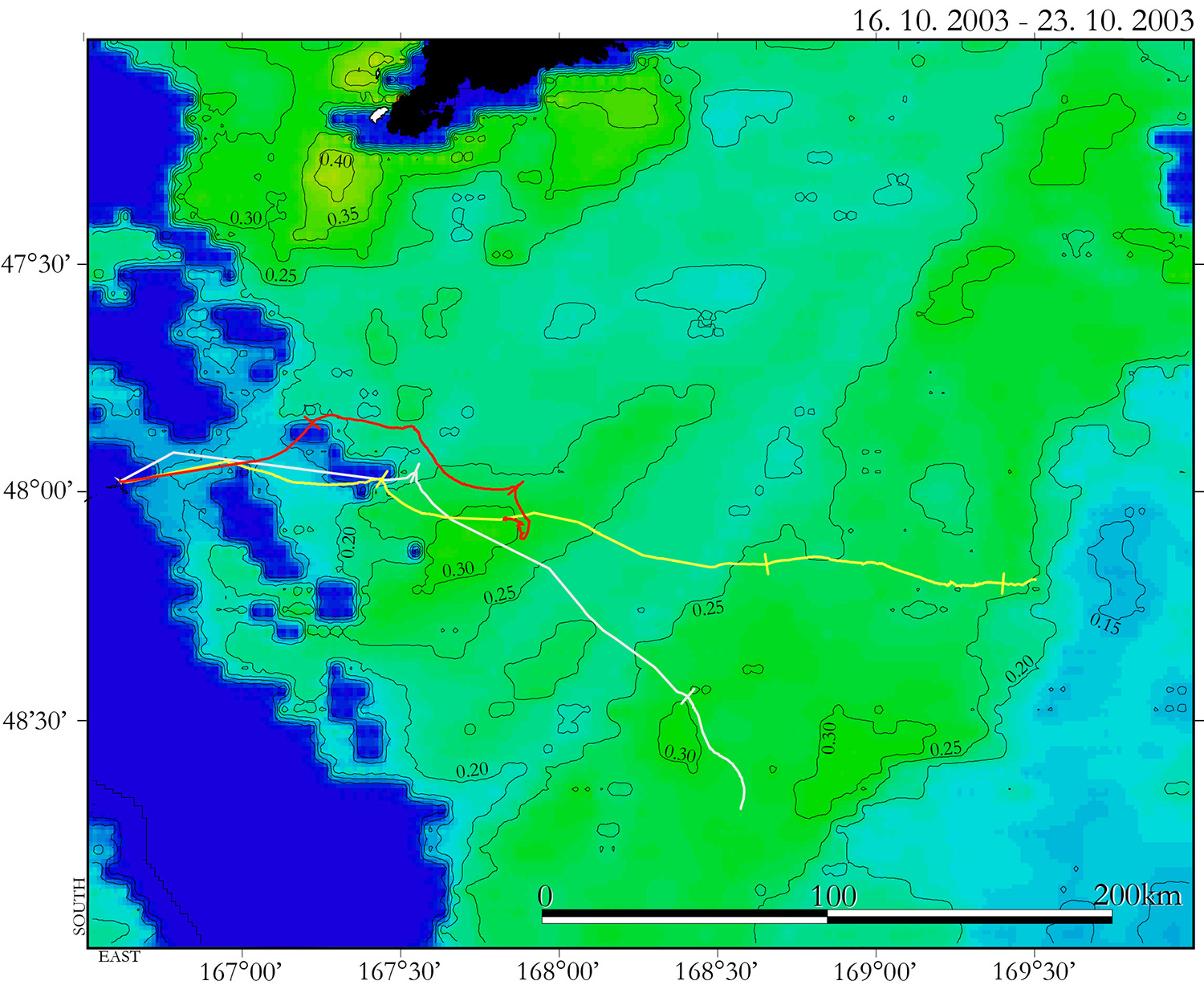
Figure 6. Partial foraging trips of male penguins during incubation period. Three birds were tracked for 2-3 days; dash marks indicate daily segments of the tracks. The birds sought out regions with increased chlorophyll a concentrations (green areas). Adapted from Mattern39.
When feeding young chicks, female Snares penguins were foraging within a 100 km radius north and northeast of the island, where they spent on average 32-37 hours at sea traveling up to 160 km. There were marked differences in dive depths between the two years that data was recorded, with penguins diving for longer and to greater depths in 2004 than in 2003 (2003 vs. 2004 - dive time: 56±11 s vs. 80±16 s; dive depth: 18±4 m vs. 29±8 m). A likely depression of the thermocline hence deeper distribution of the penguins’ prey probably explains these differences. Most foraging dives were recorded at least 50 km from the Island and it appeared as if the birds sought out warmer waters close to Stewart Island7.
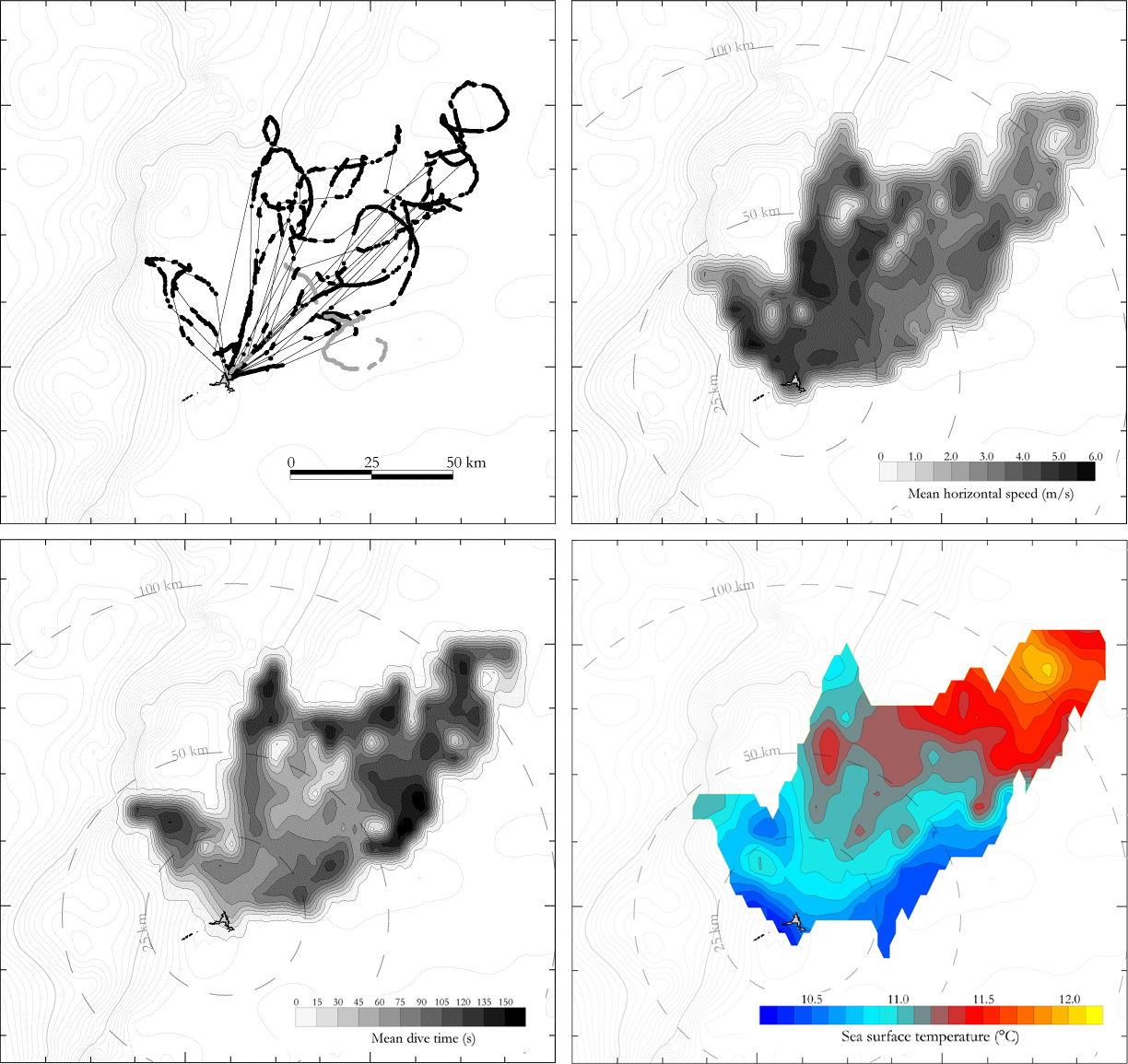
Figure 6. Foraging patterns of female Snares penguins during the chick rearing period (top left graph). Spatial disrtibution of horziontal swim speeds (top right) and dive times (bottom left) shows the penguins affinity to forage in warmer waters to the North (bottom right). Adapted from Mattern39.
In 2014, researchers from NIWA deployed geolocator devices on 45 Snares penguins at the end of the moult. Using light sensors to measure sunrise and sunset times to approximate the penguins’ geographic position throughout winter, the study managed to reconstruct the travel paths of a number of birds. The penguins generally headed west, past Tasmania to regions about 1,500 km south of south-central Australia before returning to their breeding colonies in September11. It is likely these patterns have remained the same at least over the last several thousand years, as prehistoric Snares (or crested) penguin remains have been often been recorded in Tasmania29.
Threats
A summary of threats have been published in Mattern5. Here, we expand on that list and rank threats into major, medium and minor categories.
Environmental disasters
Oil spills - Medium
Oil spills following shipping disasters would likely have a localized impact near and downstream of the wreckage. The oil spill caused by the wreckage of the container vessel Rena in 2016 severely affected some 20-30 km of coast line in the Bay of Plenty44, although the impact could have been more widespread if more oil had spilt from the wreck45. Compared to the mainland, marine traffic near The Snares is sparse (https://www.marinetraffic.com/en/ais/home/centerx:167.3/centery:-47.9/zoom:8) but as the islands are uninhabited and far removed from oil spill response infrastructure, while an oil spill is unlikely the consequences are dire, particularly so if it occurred during the breeding season when most of the world population is feeding locally. The greatest threat of oil spill, therefore, comes from cruise ships and fishing vessels that visit the islands throughout their summer breeding season.
There are active offshore petroleum exploration permits for seas some 150 km to the northeast of the Snares as well as other petroleum exploratory wells within a 200 km radius spanning from southeast to northeast of The Snares (http://data.nzpam.govt.nz/permitwebmaps?commodity=petroleum). These areas are visited by male penguins during the incubation phase so that any oil leakage could potentially affect the birds. However, with the prevailing eastwards and northwards currents that characterize this section of the ocean, it seems unlikely that oil leaks from these sources would reach The Snares.
Fisheries interactions
Resource competition - Medium
There are fisheries that target the Snares penguins’ main fish and cephalopod prey species. The commercial fishing zones adjacent to the Snares include a substantial fishery for red cod (Pseudophycis bachus) (2017/18fishing season: up to 281,000 kg); arrow squid (Nototodantarus sloanii) (up to 2,920,000 kg), and redbait (Emmelichthys nitidus) (up to 21,000 kg)46, all of which are believed to be important prey items for adult Snares penguins during the breeding season8. Hence, there is potential for resource competition.
Incidental bycatch - Medium
While the set-net fishery in New Zealand is largely confined to the continental shelf surrounding the mainland, the Snares penguins’ tendency to forage close to Stewart Island during the chick-rearing period may expose them to set-nets. Moreover, it appears that some set netters may have been operating near The Snares. If that were the case, it could be devastating considering most of the population are commuting to and from the island throughout the breeding season5.
Predators
Natural predators
The main predators of Snares penguins are assumed to be Hooker’s sea lions (Phocarctos hookeri), New Zealand fur seals (Arctocephalus fosteri) and leopard seals (Hydrurga leptonyx)5. Other marine predators probably include sharks and orca (Orcinus orca)21. Predation at sea is assumed to be infrequent. On land, chicks and injured or sick adult Snares penguins may fall prey to Subantarctic skuas (Catharacta antarctica lonnbergi); eggs and small chicks that have fallen out of the nest may sometimes be scavenged by red-billed gulls (Larus novaehollandiae)5. Fledglings making their way to the ocean are intercepted and killed by northern giant petrels (Macronectes halli) that congregate at the main penguin launching areas in January42. The Snares are one of the few regions in New Zealand that has never had introduced terrestrial mammalian predators.
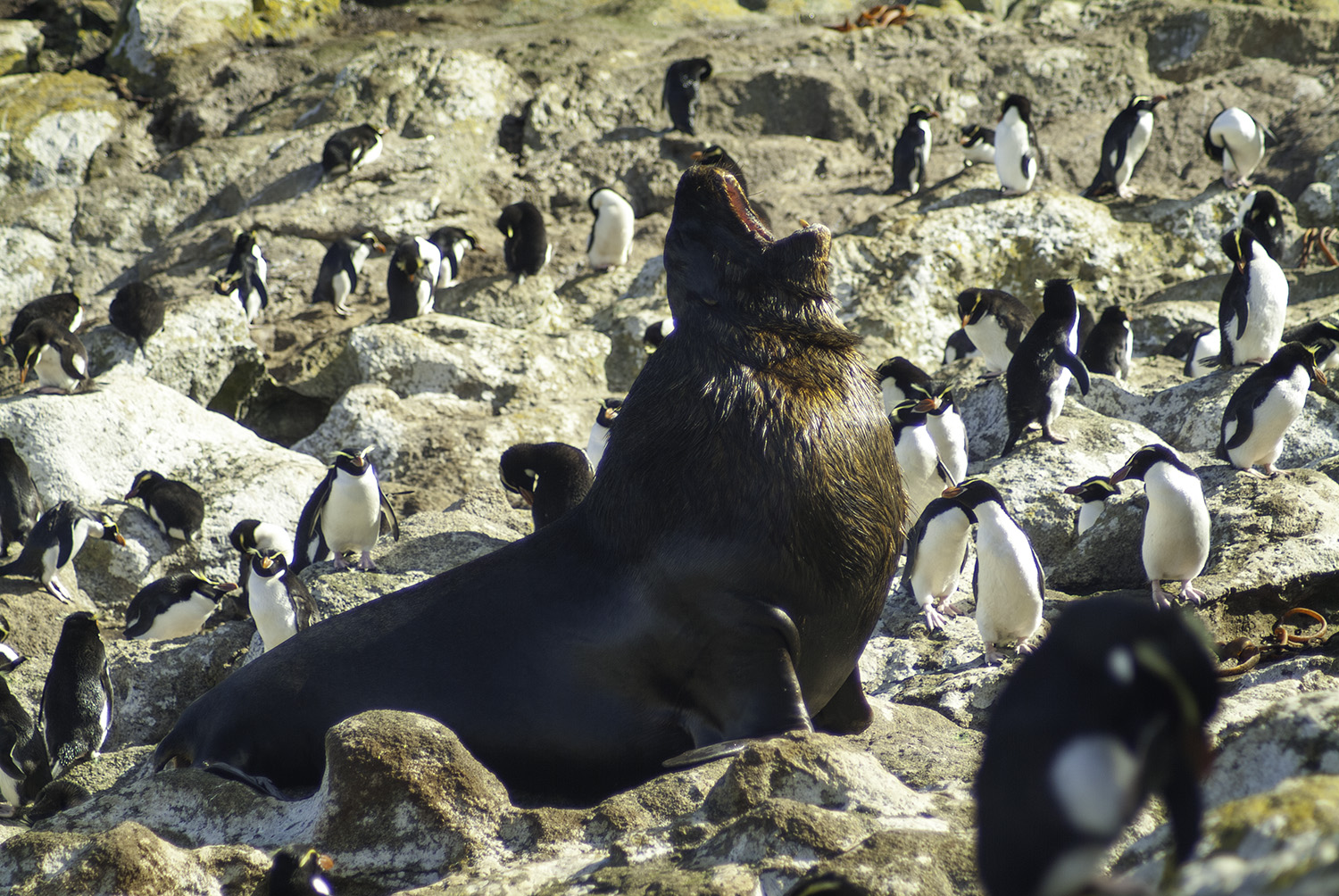
Figure 7. A male sea lion amongst a group of Snares penguins, Station Cove, North East Island, The Snares (Photo: Thomas Mattern).
Introduced predators - Minor
The Snares are the only near-pristine island groups in New Zealand. So far none of the introduced mammal predators that prey on mainland penguins have got to The Snares. The accidental introduction of mammals would have catastrophic consequences for the entire island ecosystem. Probably the greatest risk is the introduction of rats as a result of illegal landings from fishing vessels47.
Disease
AWith the information at hand (or the lack thereof), it is impossible to say to what degree Snares penguins may be affected by diseases. Penguins with what appeared to be a skin disease resulting in bare patches of skin on the face and flippers have occasionally been observed (Mattern, pers. obs.). Currently, The Snares are rarely visited and research deemed by DOC as non-essential and is, thus, discouraged. Hence, a disease outbreak would be unlikely to be detected. Similarly, there is no information on the prevalence of potential disease vectors. As a result, it is impossible to assess the threat level.
Avian malaria - unknown
Avian malaria was detected in Snares penguins in the 1940s43. Recent outbreaks of the disease in yellow-eyed penguins on the mainland show the growing risk this mosquito-borne parasite poses due to climate change. The Snares, where mosquitoes have been found to be present but not yet recorded breeding there43, with its many small bodies of standing water probably provide breeding sites for mosquitos48. If a warmer climate translates to an increased prevalence of mosquitoes on The Snares, this may increase the risk of avian malaria outbreaks48. As the Snares are seldom visited, such outbreaks will likely go unnoticed.
Avipox - unknown
In the 2017/18 breeding season, the first death of a New Zealand penguin – a tawaki chick – from infection of the avian poxvirus (Poxviridae) has been confirmed (Ralph Vanstreels, pers. comm.). Tawaki are frequent visitors to The Snares, which could facilitate transmission of the disease if suitable vectors were present. While sand flies (the most likely vector for tawaki) are absent on The Snares, mosquitoes are possible vectors. As with outbreaks of avian malaria, it seems unlikely that the current management would allow the detection of an outbreak of this disease.
Climate change
Ocean warming - unknown
Rising sea surface temperatures have been implicated as a factor causing population declines in other crested penguin populations in New Zealand and elsewhere12,49–51. The population of Snares penguins has apparently been stable throughout the last century despite significant variations in ocean temperatures8. However, ocean temperatures around New Zealand mainland – the same water mass that also surrounds The Snares – have been rising steadily in the past 20 years and have contributed to the population declines in yellow-eyed penguins52. The impact ocean warming may have on Snares penguins is unknown.
Weather extremes (El Niñ/La Niña) - unknown
The El Niño weather phenomenon appears to negatively affect tawaki along the open coast of New Zealand; the strong 2015/16 El Niño resulted in extremely poor breeding success53. Snares penguins forage in a similar marine environment; however, whether El Niño conditions also affect their breeding performance is unknown.
Human impacts
Cruise vessels - Minor
The Snares are visited by various cruise vessels that operate in the New Zealand sub-Antarctic region. While landings are not permitted passengers are usually transported close to the shore in inflatable boats. While Snares penguins appear to have a greater tolerance to human presence than other penguin species, constant exposure to human disturbance may still affect the birds54. People in boats may be perceived differently by the penguins than people on land, which makes it difficult to assess to what degree penguins may be affected by cruise boat visitors.
Research interactions - Minor
The Department of Conservation restricts visitors to The Snares to an extent that it limits research on the penguins5. Compared to penguin species on the mainland, Snares penguins are remarkably tolerant to the presence of humans. Only intensive interactions like daily handling of eggs over extended periods have been found to be a significant cause of stress for the penguins, while infrequent close-quarter interactions have no apparent effect on the birds54. As such, researcher impact if managed properly does not negatively impact on the birds.
Research Priorities
Together with the endangered Erect-crested penguin, Snares penguins are the least known and studied of the world’s penguin species. Considering the relative proximity of The Snares to the New Zealand mainland research on the species should be logistically more feasible than species inhabiting the other sub-Antarctic islands. However, because their population is stable, research on the species is deemed non-essential by the Department of Conservation. If the population starts declining it will be difficult to assess the driving causes, and develop effective management strategies, a scenario that has emerged in the recent decades for Erect-crested and Eastern rockhopper penguins. We suggest that research that provides baseline information on Snares penguins is vital for future management actions.
1. Population monitoring
| R.1.H1 |
Continue comprehensive ground surveys at 3-6-year intervalsThe ground surveys conducted by the Department of Conservation in the past 20 years have provided the only robust and reliable population assessments available for any of the New Zealand penguin species. It is vital that this research continues using similar methodologies. The interval of these surveys ideally should be shorter. In the past surveys were conducted every 7 or 8 years (with the exception of a re-survey two years after a decline in penguin numbers was detected). If the population was affected by a disease outbreak or environmental catastrophes, these may not be detected for some years. Conduct complete ground counts of penguins on the entire Snares archipelago, on two consecutive years at 3-6 year intervals. |
| R.1.H2 |
Investigate viability of automated monitoring solutionsWhile ground surveys allow reliable and robust censuses of the Snares penguin breeding population, the infrequent nature of these surveys makes it difficult to detect population trends in a timely manner. As with the other sub-Antarctic crested penguin species, the use of automated time-lapse camera monitoring systems may offer a viable solution to this dilemma55–57. Investigations into best practices and reliability of such systems should be of a high priority. Deploy a network of cameras to establish deployments and maintenance protocols and examine accuracy of penguin counts from time-lapse imagery under different conditions (i.e. forest vs open, small vs. large colonies). |
| R.1.H3 |
Initiate studies to gather information on key demographic parameters, including survival rates, breeding success and recruitment.Breeding success is one of the key demographic parameters and is vital for population modelling. Time-lapse photography may be suitable to monitor breeding success as well as return rates of juveniles. Survival rates can only be determined using a marked population; the penguin landing at Station Cove would be ideal for an automated ID gateway. Establish a network of time-lapse cameras to determine annual breeding success. Larger colonies may be most suitable. The best set-up for the monitoring systems need to be determined so that eggs, chicks and later crèches can be counted from the footage. |
| R.1.M4 |
Investigate the causes of breeding failure and whether colony properties such as exposed vs. forest colonies and colony size influence breeding success |
| R.1.M5 |
Examine prevalence of diseases and abundance of disease vectorsParticularly, with regards to avian pox which has recently caused mortality in tawaki chicks and avian malaria which has become an issue in mainland Yellow-eyed penguin populations. |
| R.1.L6 |
Determine the degree of asynchrony in timing of breeding between the main island and Western Chain. |
| R.1.L7 |
Study the impact skuas, pinnipeds and giant petrels have on mortality of eggs, chicks and adults. |
2. Marine Ecology
| R.2.H1 |
Record baseline information on foraging ecology during breedingOur current knowledge of the Snares penguin’s marine ecology is based on a few deployments of GPS dive loggers in the early 2000s. The data does not provide enough information to assess how the penguins may be affected by a changing climate and increasing ocean temperatures. A five-year research programme (similar to the one currently conducted on tawaki) will provide a solid baseline that can be used in the future. Ideally, this research would be conducted in tandem on the main island and the Western Chain to establish whether the apparent differences in the timing of breeding are reflected in the foraging behaviour of the penguins.
|
| R.2.H2 |
Examine pre-moult and winter dispersalThe pre-moult period is probably the most crucial period for any migratory penguin species, especially if the penguins have just completed their resource demanding breeding. Hence, foraging success during the pre-moult dispersal is likely to be crucial for adult survival. Track Snares penguins’ annual pre-moult dispersal using geolocator devices (GLS) that can be deployed for long periods (up to 5 years, minimal maintenance). Examine whether this could also be achieved with GPS dive loggers (i.e. similar to Whitehead et al.58). Tracking Snares penguins during their winter dispersal will show whether the penguins are exposed to different threats to those close to their breeding colonies and provide further information about environmental variables dictating their movement patterns and survival. Track Snares penguins through their winter dispersal with GLS loggers and satellite transmitters every 3-5 years |
| R.2.H3 |
Comprehensive study of diet composition using faecal DNA analysis and deployment of animal-borne cameras. |
| R.2.H4 |
Stable isotope analysis of blood, ideally in conjunction with tawaki, during incubation period to examine which water masses are visited during longer foraging trips. |
| R.2.M5 |
If timing differences between the main island and Western Chain are verified, conduct comparative study of at-sea movements of birds from both areas. |
3. Disease Monitoring
| R.3.M1 |
Screen the population for avian malariaRepeat the study from the 1940s to determine the prevalence of Plasmodium in the penguins and other resident seabird species (e.g. sooty shearwaters) and introduced songbirds (blackbirds, thrush). |
| R.3.M2 |
Investigate prevalence of disease vectorsThe Snares may provide ideal breeding ground for disease vectors like mosquitoes. Particularly problematic areas (e.g. ponds, depressions prone to flooding) on the island need to be located and mapped to facilitate their future management. |
| R.3.M3 |
Investigate potential gateways for disease vectorsAssess the presence of potential disease vectors and investigate how these could arrive on The Snares. This is essential to develop effective quarantine protocols. |
Acknowledgments
We thank Teresa Cole, Kyle Morrison, Graeme Taylor and Dave Houston for valuable criticism and comments that helped to greatly improve previous versions of this species account. This review was funded by the T-Gear Charitable Trust and the Birds New Zealand Research Fund. Thanks so much for supporting our work. We are especially grateful to Peter Gaze for his support and interest throughout.
References
- Warham, J. (1974) The breeding biology and behaviour of the snares crested penguin. Journal of the Royal Society of New Zealand 4: 63–108 DOI: https://doi.org/10.1080/03036758.1974.10419407
- Marchant, S & Higgins, PJ. (1990) Eudyptes robustus Snares penguin. in Handbook of Australian, New Zealand and Antarctic Birds, Vol 1A 205–214 (Oxford University Press).
- Johns, PM et al. (1986) Snares Island Expedition 1985-1986. Christchurch, New Zealand.
- Miskelly, CM et al. (1987) Snares Island Expedition 1986-1987. Christchurch, New Zealand.
- Mattern, T. (2013) Snares penguin (Eudyptes robustus). in Penguins: Natural History and Conservation (eds. Garcia Borboroglu, P. & Boersma, P. D.) 168–183 (University of Washington Press).
- Proffitt, FM & McLean, IG. (1990) Recognition of Parents’ Calls by Chicks of the Snares Crested Penguin. Bird Behavior 9: 103–113 DOI: https://doi.org/10.3727/015613890791749118
- Mattern, T. (2006) Marine Ecology of offshore and inshore foraging penguins: the Snares penguin Eudyptes robustus and Yellow-eyed penguin Megadyptes antipodes. PhD: (University of Otago).
- Mattern, T, Houston, DM, Lalas, C, Setiawan, AN & Davis, LS. (2009) Diet composition, continuity in prey availability and marine habitat – keystones to population stability in the Snares Penguin (Eudyptes robustus). Emu 109: 204–213 DOI: https://doi.org/10.1071/MU0800
- Massaro, M & Davis, LS. (2004) Preferential incubation positions for different sized eggs and their influence on incubation period and hatching asynchrony in Snares crested (Eudyptes robustus) and yellow-eyed penguins (Megadyptes antipodes). Behavioral Ecology and Sociobiology 56: 426–434 DOI: https://doi.org/10.1007/s00265-004-0803-8
- McGraw, KJ, Massaro, M, Rivers, TJ & Mattern, T. (2009) Annual, sexual, size- and condition-related variation in the colour and fluorescent pigment content of yellow crest-feathers in Snares Penguins ( Eudyptes robustus ). Emu 109: 93 DOI: https://doi.org/10.1071/MU08034
- Thompson, DR. (2016) Penguins reveal unknown swimming talents. NIWA media release https://www.niwa.co.nz/news/penguins-reveal-unknow Available at: https://www.niwa.co.nz/news/penguins-reveal-unknown-swimming-talents.
- Taylor, GA. (2000) Action Plan for Seabird Conservation in New Zealand. Part A: Threatened Seabirds. Department of Conservation, New Zealand. Wellington.
- Oliver, WRB. (1953) The Crested Penguins of New Zealand. Emu 53: 185–187
- Falla, RA. (1935) Notes on penguins of the genera Megadyptes and Eudyptes in Southern New Zealand. Records of the Auckland Institute and Museum 1: 319–326
- Kinsky, FC. (1970) Annotated checklist of the birds of New Zealand including the birds of the Ross Dependency. (Reed).
- Stonehouse, B. (1971) The Snares Islands Penguin Eudyptes robustus. Ibis 113: 1–7
- Falla, RA, Warham, J & Fleming, CA. (1974) Comments on the proposed preservation of Eudyptes sclateri Buller, 1888 and Eudyptes robustus (Oliver, 1953). Bulleting of Zoological Nomenclature 30: 136
- Baker, AJ, Pereira, SL, Haddrath, OP & Edge, K-A. (2006) Multiple gene evidence for expansion of extant penguins out of Antarctica due to global cooling. Proceedings of the Royal Society B: Biological Sciences 273: 11–7 DOI: https://doi.org/10.1098/rspb.2005.3260
- Ksepka, DT, Bertelli, S & Giannini, NP. (2006) The phylogeny of the living and fossil Sphenisciformes (penguins). Cladistics 22: 412–441 DOI: https://doi.org/10.1111/j.1096-0031.2006.00116.x
- Davis, LS & Renner, M. (2003) Penguins. (T&AD Poyser).
- Cole, TL et al. (2019) Ancient DNA of crested penguins: Testing for temporal genetic shifts in the world’s most diverse penguin clade. Molecular Phylogenetics and Evolution 131: 72–79 DOI: https://doi.org/10.1016/j.ympev.2018.10.025
- Christidis, L & Boles, W. (2008) Systematic and taxonomy of Australian birds. CSIRO Publishing Available at: http://www.publish.csiro.au/book/5702/%0Ahttps://academic.oup.com/sysbio/article-lookup/doi/10.1093/sysbio/syp071.
- Tobias, JA et al. (2010) Quantitative criteria for species delimitation. Ibis 152: 724–746 DOI: https://doi.org/10.1111/j.1474-919X.2010.01051.x
- Fleming, C & Baker, A. (1973) The Snares Western Chain. Notornis 20: 37–45
- Sagar, PM. (1977) Birds of the Western Chain, Snares Islands, New Zealand. Notornis 24: 178–183
- Miskelly, CM, Sagar, PM, Tennyson, AJD & Scofield, RP. (2001) Birds of the Snares Islands, New Zealand. Notornis 48: 1–40
- BirdLife International. (2017) Eudyptes robustus (amended version of assessment). he IUCN Red List of Threatened Species 2017 e.T22697782A119108497 DOI: https://doi.org/10.2305/IUCN.UK.2017-3.RLTS.T22697782A119108497.en
- Miskelly, CM & Bell, M. (2004) An unusual influx of Snares crested penguins (Eudyptes robustus) on the Chatham Islands, with a review of other crested penguin records from the islands. Notornis 51: 235–237
- Cole, TL et al. (2017) Ancient DNA reveals that the ‘extinct’ Hunter Island penguin (Tasidyptes hunteri) is not a distinct taxon. Zoological Journal of the Linnean Society 182: 459–464 DOI: https://doi.org/10.1093/zoolinnean/zlx043
- Woehler, EJ. (1992) Records of vagrant penguins from Tasmania. Marine Ornithology 20: 61–73
- Lamey, TC. (1990) Snares Crested Penguin in the Falkland Islands. Notornis 37: 78
- Demongin, L, Poisbleau, M, Strange, G & Strange, IJ. (2010) Second and Third Records of Snares Penguins (Eudyptes robustus) in the Falkland Islands. The Wilson Journal of Ornithology 122: 190–193 DOI: https://doi.org/10.1676/09043.1
- Warham, J, Spurr, EB & Clark, WCC. (1986) Research on penguins in New Zealand. Wildlife Research Liaison Group. Wellington.
- Tennyson, AJD. (1987) Snares Crested Penguin (Eudyptes robustus) census. in Snares Island Expedition 1986-1987 (ed. Miskelly, C. M.) 28–35 (Zoology Department, University of Canterbury, Christchurch, NZ).
- Hiscock, JA & Chilvers, BL. (2016) Snares crested penguins Eudyptes robustus population estimates 2000-2013. New Zealand Journal of Ecology 40:
- McLean, I, Johns, P & Miskelly, CM. (1988) Snares Crested Penguins : A preliminary Life History Table. Cormorant 16: 130
- Amey, JM, Houston, DM, Tennyson, AJD & McAllister, AK. (2001) Census of the Snares crested penguin (Eudyptes robustus) breeding population. Wellington.
- Miskelly, CM. (1984) BIRDS OF THE WESTERN CHAIN, SNARES ISLANDS 1983-84. Notornis 31: 209–223
- Mattern, T, Ellenberg, U, Houston, DM & Davis, LS. (2018) Like clockwork - nest attendance patterns and foraging behaviour of Snares penguins Eudyptes robustus as a function of daylength and oceanography. PeerJ Preprints 6: e26653v1 DOI: https://doi.org/10.7287/peerj.preprints.26653v1
- Proffitt, FM. (1988) Chick recognition of parents’ call in Snares Crested penguins. Cormorant 16: 132
- Mattern, T, Ludynia, K, Houston, DM, Garthe, S & Davis, LS. (2005) How to get the most (or anything) out of GPS loggers: a case study with Snares penguins. DOI: https://doi.org/10.13140/RG.2.2.15528.26881
- Horning, D & Horning, C. (1974) Bird Records Of The 1971-1973 Snares Islands, New Zealand, Expedition. Notornis 21: 13–24
- Vanstreels, RET, Braga, ÉM & Catão-Dias, JL. (2016) Blood parasites of penguins: A critical review. Parasitology 143: 931–956 DOI: https://doi.org/10.1017/S0031182016000251
- Jones, H, Poot, M, Mullarney, J, de Lange, W & Bryan, K. (2016) Oil dispersal modelling: reanalysis of the Rena oil spill using open-source modelling tools. New Zealand Journal of Marine and Freshwater Research 50: 10–27 DOI: https://doi.org/10.1080/00288330.2015.1112819
- Schiel, D, Ross, P & Battershill, C. (2016) Environmental effects of the MV Rena shipwreck: cross-disciplinary investigations of oil and debris impacts on a coastal ecosystem. New Zealand Journal of Marine and Freshwater Research 50: 1–9 DOI: https://doi.org/10.1080/00288330.2015.1133665
- Ministry of Primary Industries. (2018) National Aquatic Biodiversity Information System (NABIS). http://www.nabis.govt.nz
- Dingwall, P. (1995) Progress in conservation of the subantarctic islands. (IUCN).
- Tompkins, DM & Gleeson, DM. (2006) Relationship between avian malaria distribution and an exotic invasive mosquito in New Zealand. Journal of the Royal Society of New Zealand 36: 51–62 DOI: https://doi.org/10.1080/03014223.2006.9517799
- Cunningham, DM & Moors, PJ. (1994) The Decline of Rockhopper Penguins Eudyptes chrysocome at Campbell Island, Southern Ocean and the Influence of Rising Sea Temperatures. Emu 94: 27–36
- Morrison, KW, Battley, PF, Sagar, PM & Thompson, DR. (2015) Population dynamics of Eastern Rockhopper Penguins on Campbell Island in relation to sea surface temperature 1942–2012: current warming hiatus pauses a long-term decline. Polar Biology 38: 163–177
- Hilton, GM et al. (2006) A stable isotopic investigation into the causes of decline in a sub-Antarctic predator, the rockhopper penguin Eudyptes chrysocome. Global Change Biology 12: 611–625
- Mattern, T et al. (2017) Quantifying climate change impacts emphasises the importance of managing regional threats in the endangered Yellow-eyed penguin. PeerJ 5: e3272 DOI: https://doi.org/10.7717/peerj.3272
- Mattern, T & Ellenberg, U. (2016) The Tawaki Project: Field Report 2015 - year 2, 13 September-14 October 2015. NZ Penguin Initiative. Dunedin, NZ. DOI: https://doi.org/10.13140/RG.2.1.3068.1847
- Ellenberg, U, Mattern, T, Houston, DM, Davis, LS & Seddon, PJ. (2012) Previous experiences with humans affect responses of Snares Penguins to experimental disturbance. Journal of Ornithology 153: DOI: https://doi.org/10.1007/s10336-011-0780-4
- Jones, FM et al. (2018) Time-lapse imagery and volunteer classifications from the Zooniverse Penguin Watch project. Scientific Data 5: 180124 DOI: https://doi.org/10.1038/sdata.2018.124
- Black, C, Rey, AR & Hart, T. (2017) Peeking into the bleak midwinter: Investigating nonbreeding strategies of Gentoo Penguins using a camera network. The Auk 134: 520–529 DOI: https://doi.org/10.1642/AUK-16-69.1
- Black, C, Southwell, C, Emmerson, L, Lunn, D & Hart, T. (2018) Time-lapse imagery of Adélie penguins reveals differential winter strategies and breeding site occupation. PLOS ONE 13: DOI: https://doi.org/10.1371/journal.pone.0193532
- Whitehead, TO, Kato, A, Ropert-Coudert, Y & Ryan, PG. (2016) Habitat use and diving behaviour of macaroni Eudyptes chrysolophus and eastern rockhopper E. chrysocome filholi penguins during the critical pre-moult period. Marine Biology 163: 1–20 DOI: https://doi.org/10.1007/s00227-015-2794-6